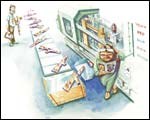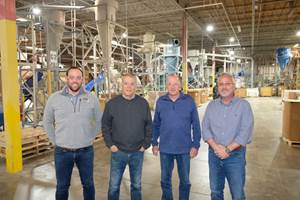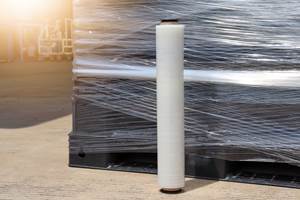Headlines for the Next 50 Years
Ever wonder what it would be like to get tomorrow’s newspaper today? After reviewing the most important technical developments of the past 50 years in our October issue, we asked industry experts to help us imagine the biggest headlines in plastics from now to 2055. What we got was a mixture of predictions of what will happen and a wish list of what should happen.
- Additives
- Stretch Blow Molding
- Thermoforming
- Elastomers
- Engineering Resins
- Micromolding
- Blow Molding
- nanocomposites
- Materials
- All Electric & Hybrid Machines
- Processes
- Barrier Blow Molding
- Recycling
- Automation
- sustainability
- Postprocessing
- Compounding
- Processes
- Injection Molding
- Postconsumer
- Multiscrew
Say Hello to Nano Molding
The new frontier of injection molding is “shrinking,” says Carl Schiffer, managing partner at Dr. Boy GmbH in Germany. Miniaturization in electronic and medical parts will help push today’s micro-molding toward “nano”-size parts. Machinery will need to evolve to meet the “nano” challenge. Shot sizes must become smaller, and screw diameters are already shrinking from the standard lower limit of 14 mm. Boy’s newest screw size, the first 12-mm model on the market, is being used to produce parts weighing 0.0009 g from a shot weight of just 0.001 g.
Hot-runner systems will also need to evolve to accommodate tiny shots. So will parts-removal and handling systems, since air drafts and static electricity will present major challenges when dealing with flyspeck-sized bits of plastic.
Make Way for the‘Microwave-Truder’
There has got to be something better than the single-screw extruder as a plasticating mechanism, says Russ LaBelle, founder and president of Wilmington Machinery Inc., Wilmington, N.C. “It’s not the most efficient way of melting plastics.” He anticipates a “new apparatus to melt plastics using some new form of energy such as microwaves.”
Robert Kadykowski, director of corporate development at Xaloy in Newcastle, Pa., predicts the invention of a technique for more energy-efficient conversion of resin into parts. “We’ve got to find ways of taking cost out, and energy savings are the last venue for making processing cost-competitive in North America.” He notes that extruders and molding machines have already begun switching to more energy-efficient drives with electric servo motors and synchronous torque motors.
LaBelle says blow molders continually fight a battle to keep melt temperatures low to save energy and minimize resin degradation while needing temperatures high enough to obtain a uniform melt. Twin-screw extruders can provide a uniform melt at lower temperature, says LaBelle, but their higher cost has made them rare in blow molding so far.
There’s plenty of R&D on new plasticating devices. The cone extruder from Conenor Ltd. in Lahti, Finland, has demonstrated good energy efficiency, and the University of Paderborn in Germany is experimenting with a stubby melting device that uses a 700-rpm screw in a grooved cylinder and melts so fast that it needs no heater bands.
Researchers are looking into other methods of plastication, such as ultrasonic vibration to achieve a temporary reduction in viscosity, notes Roger Avakian, chief technology officer at PolyOne in Avon Lakes, Ohio. The University of Akron is looking at this and other novel methods.
Donald Paulson of Paulson Training Programs Inc., Chester, Conn., expects that “highly conductive plastics will be developed that will allow inductive heating. In some plastics micro wave heating will be applicable to replace plasticating screws. These approaches will revolutionize energy consumption in plastic extrusion.”
Blow Molders Go All-Electric
It’s a good guess that energy will never be cheap again, and power consumption will loom larger in machine-buying decisions. Odds are that energy efficiency will spur greater use of all-electric blow molding machines, bets Sam Belcher, president of Sabel Plastics, Moscow, Ohio. While only a handful of machine manufacturers make them now, all-electrics will proliferate as energy concerns take center stage. “In the past, we sort of ignored energy costs,” says Belcher. “But the future holds real challenges in energy cost and availability, and suppliers will respond with all-electric machines and ways to control maximum power factor.”
Biopolymer Revolution Arrives
Use of renewable natural resources to produce plastics will explode over the next half-century as oil and other energy sources become scarcer and more costly. Plastics based on cornstarch—poly lactic acid (PLA) and starch-based resins—are already on the market, as are thermoset polyesters and urethane polyols based on soybean oil. A key challenge will be the development of a cost-efficient infrastructure to convert natural materials into resins.
Great strides already have been made in narrowing the cost gap. Since the early 1990s, the cost differential in manufacturing biopolymers versus petrochemical-derived plastics has been cut from 35:1 down to 5:1. As technology is refined and bigger plants come on-line, economies of scale similar to oil-based plastics will be realized, according to industry observers. Europe and the Far East will move faster to utilize biopolymers due to pressing environmental regulations such as the Kyoto Protocol, which requires a reduction in greenhouse gases.
A tougher task will be to attain engineering-resin-type performance. Biopolymers based on agricultural resources can go only so far in terms of property profile, according to Dr. Donald Rosato, plastics engineer and consultant in Concord, Mass. The new frontier in biopolymers will focus on genetic engineering of microbes to maximize their production of useful substances. Instead of relying on farming, biopolymer production would be based on fermentation “bio-reactors.” This direction is already being explored by firms such as Metabolix Inc., Cambridge, Mass., and Procter & Gamble, Cincinnati.
Len Kulka, director of creative development at Clariant Masterbatches, Holden, Mass., foresees selective uses of biopolymers to get around their property limitations in the near term. “One could imagine using a masterbatch with a high concentration of renewable polymer as the carrier resin for color and additives. This masterbatch could be let down with petroleum-based resin in the processing machine.” He also envisions that renewable polymers could be used as an internal layer between skins of conventional plastics.
Soybean-Based Polyols Win in PUR
In the next 10 to 15 years, vegetable-oil-based polyols could replace petroleum-derived ingredients in a range of polyurethane foams, elastomers, coatings, adhesives, and sealants. Dow Polyurethanes, Midland, Mich., is one of the companies developing new families of vegetable-oil-based PUR polyols. According to Mike Haschke, project director at Dow, these polyols eliminate steps in the production process. “Genetic modification of seed oils could theoretically produce commercially useful products directly from the green plant,” he says. Dow is first testing flexible-foam polyols. Production success has been achieved at the lab and pilot-plant scale, and commercial trials are under way with select customers.
Cars Made of Biopolymers
Poly lactic acid (PLA) biopolymer made by bacterial fermentation has already been used in Japan to make notebook computer housings, pipes, and prototype cellphones—so why not car parts? Toyota in Japan unveiled the Raum SUV in 2003, which had floor mats and a spare-tire cover made from Toyota’s Eco-Plastic PLA reinforced with kenaf plant fiber. Toyota makes PLA from cane sugar and sweet potatoes. In the future, Rose Ryntz, senior manager of advanced material engineering at Visteon Corp., Dearborn, Mich., expects to see a “bio-based polymer cockpit that’s fully recyclable.”
In-Line Compounding Aids Blow Molding
Make your own material—that’s the route to better blow molded parts at lower cost, according to long-time expert Robert Slawska, president of Proven Technology, Hillsborough, N.J. In-line compounding will allow molders to produce custom-tailored material combinations on demand. “By compounding at the machine, superior parts will emerge with properties such as better Class A finish for automotive hoods and trunk lids,” Slawska expects.
Nanocomposites Prove Their Worth
What’s little is big—very big—in the future of engineering thermoplastics, says Dr. Donald Rosato, a long-time plastics engineer and consultant in Concord, Mass. He says nano-fillers’ impact will be felt especially in electrical/electronic applications for very high-performance materials like polysulfone, PPS, LCP, and PEEK. Nano-filled parts will end up costing less at no sacrifice in performance, says Rosato. The net effect will be to bring the cost of these high-heat resins down close to that of standard engineering materials such as PC and nylon.
By serving as a new type of compatibilizer, nano-clays will allow production of new categories of thermoplastic alloys, so formulators can mix and match properties of different materials for optimum cost-effectiveness. One demonstration is a new PP/PS/nanoclay blend called Elan XP, developed by Putsch GmbH in Nurenberg, Germany, together with the clay supplier Sud-Chemie AG, Moosburg, Germany. The Monofil nano-clay is first blended into the PP, and then the PS is added, which “hides” from the incompatible PP in the spaces between the exfoliated layers of clay. The result is a highly scratch-resistant material with very low shrinkage, high flow, impact strength similar to ABS, and a matte finish. It is being used in unpainted car and truck interior trim.
Future nano-additives may go beyond the inorganic mineral types that are today’s focus. Plastics packaging expert Eldridge M. Mount III, head of consulting firm Emmount Technologies, LLC, Fairport, N.Y., envisions organic carbon-based nano-platelets that are built into the resins during polymerization, perhaps as a catalyst support medium.
Nanocomposites will also find a home in structural thermoformed applications, according to consultant James Throne, president of Sherwood Technologies Inc., Dunedin, Fla. “Thermoforming has the capability of using highly reinforced materials but the issue has always been price/performance,” explains Throne. With nano composites, thermoformers will gain metal-like and high-impact properties at affordable cost, he says.
Carbon Nanotubes Fall Below 50¢/Lb
Nanocomposites based on carbon nanotubes will become affordable, predicts Jack Avery, retired GE processing expert and president of Avery Plastics Consulting, Salt Lake City. Nanocomposites based on nanoclays, which cost in the $3/lb range, are beginning to find real-world applications. But carbon nanotubes currently sell for $100 to $1000/lb, far too expensive for most commercial uses. Early work with these exotic additives has shown their remarkable ability to enhance strength and electrical conductivity at low loadings. Once nanotubes become affordable, they will be used everywhere, Avery says. New methods of manufacturing carbon nanotubes are announced every few months. Bayer MaterialScience (U.S. office in Pittsburgh) just announced a new technology that will produce nanotubes at “significantly lower manufacturing cost.”
“We will also learn how to disperse nano-materials and not have them reagglomerate again,” says Roger Avakian, chief technology officer at PolyOne in Avon Lakes, Ohio. “For years we have relied on shear and viscosity to disperse, but we will learn to put electrical or electrostatic charges on materials to enable dispersion.”
Carbon nanotubes are especially difficult to disperse. But recent work at NASA, the University of Maryland, and elsewhere reportedly has achieved uniform dispersion and some degree of orientation of carbon nanotubes, yielding dramatic property gains.
One way to eliminate dispersion problems is to incorporate nanotubes during polymerization. “This will be done by functionalizing the nanotube and polymerizing engineering resins like PPS, PPO, and PEEK directly on it,” says William Diecks, a marketing manager at Chevron Phillips Chemical Co., The Woodlands, Texas. “In this way, you get the nanotube into the polymer structure at use levels as low as 0.1% to 0.2%. Mechanically compounding nano-materials into polymers is way too expensive an approach, requiring use levels of 2% to 5%,” Diecks adds.
Unpainted Car Parts Prevail
Insert-molded decorative films may replace most secondary painting and chrome plating in automotive and non-automotive applications within a few years. Eliminating costly secondary finishing will be essential to reducing processing, scrap, and environmental costs, predicts Dr. Donald Rosato, a consultant in Concord, Mass. The auto industry’s heavy capital investment in painting makes it cost-prohibitive to abandon it right now, but he is confident that it’s just “a matter of time” before paint-free plastics make their mark.
Large injection molded and thermoformed exterior body panels with dry paint films have been on the road for at least three years. Hendrickson International, Joliet, Ill., has thermoformed large truck bumper fascias with a bright chrome look using paint films.
Molded-in color is another “no-paint” solution, but it has been impractical so far for exterior automotive panels of thermoset SMC. Mike Dettre, business manager of closed-mold resins for AOC in Collierville, Tenn., hopes that will change with future development of resins and/or additive formulations that resist long-term outdoor exposure in SMC parts such as pickup boxes.
Polyurethane elastomers based on light-stable aliphatic chemistry are also projected to make a significant impact on cars of the future. “New technologies using aliphatic elastomers will eliminate the need to paint automobile exteriors,” says a source at Bayer MaterialScience, Pittsburgh. One application will be window seals.
If You Must Paint, Do It in the Mold
After nearly 20 years in development, and several false starts, in-mold painting will at last be practical for injection molded thermoplastics. This approach is just now proving itself in Japan, where an unnamed car company is selling an SUV with a back panel and two exterior pillar covers that come out of the mold with a Class A painted finish. The process involves first molding the part and then opening the mold slightly to allow injection of a liquid urethane-based paint. Two factors appear to have overcome previous obstacles: new one-component, VOC-free paints from Sherwin-Williams Automotive Finishes Corp., Warrensville Heights, Ohio; and the super-precise clamp movements of an all-electric press from the Japanese parent of Ube Machinery, Inc., Ann Arbor, Mich.
Sherwin-Williams will open a lab next year to demonstrate the process and provide paint testing and qualification for customers. The lab will demonstrate this Imprest process with an Ube machine, test mold, and robotics. Appliances, housewares, and electronic housings may also benefit from Imprest, says Ube senior sales/marketing manager David Bernardi.
Monolayer Is Best For Barrier Bottles
Food and beverage makers want lightweight, high-barrier bottles but they don’t want to pay a lot for them. Today’s multilayer coinjection and barrier coatings are just ‘Band-Aid’ approaches to PET’s natural limitations as a barrier material, says Sam Belcher, president of Sabel Plastics, Moscow, Ohio. For greatest simplicity and lowest machinery cost, what processors need is a plastic material that provides a monolayer, one-step solution to making a barrier bottle—one that’s easily recyclable. Resin makers are just beginning to explore new avenues in polyester chemistry: Materials such as PEN, PTN, and PBN, and blends of those with PET and/or oxygen scavengers may provide solutions.
New methods of surface functionalization could allow chemical modification of package surface layers for higher barrier. “New surface treatments could be a combination of existing technologies such as plasma, flame, or corona treatment and chemical vapor deposition (CVD),” predicts packaging expert and consultant Eldridge M. Mount III, head of Emmount Technologies, LLC in Fairport, N.Y. “Forming excited chemical species using catalytic generators will convert simple, inexpensive parts or film surfaces such as polyethylene into exotic polymers, perhaps a tenth of a micron thick, which cannot be produced by other means.” Such a new polymer surface could have enhanced barrier and could eliminate the need for coatings or vacuum metalization.
Non-Glass Fibers Beef Up Composites
In composites, the next half century will be the era of alternative reinforcements such as carbon and aramid fibers. There’s strong interest already in these non-glass reinforcements, but high prices and restricted availability make them less attractive for commercial applications, says Robert Mollman, the retired president of research at Molded Fiber Glass Companies, Ashtabula, Ohio. As capacity increases and prices fall, higher-performance reinforcements will grow in use because of their light weight and extra stiffness and/or toughness.
Another trend may be use of electrically conductive fibers—perhaps based on polymers like polyaniline—to generate heat inside parts and facilitate more uniform cures.
Thermoforming Sheds ‘Black Art’
Thermoforming has come a long way since its early days, but it still has some distance to go to graduate from “black art” to science. “We need to get the magic out of the process so that it becomes more automated,” says consultant Bill McConnell, president of McConnell Co. Inc., Fort Worth, Texas. He wants to see new ways to measure and control process variables. “If you can’t measure a variable you can’t control it.”
Instead of relying on costly trial-and-error methods, more automated systems will measure sheet temperature, sag, stretch, and vacuum. An example today is new software for infrared scanners that measure sheet temperature, vision sensors for sheet sag, and use of air pressure to counteract sag (called “zero-gravity” forming).
Automated tool changers, robotic sheet feeding, and more efficient heating systems are also coming in the future, says Bill Kent, v.p. of sales and business development at Brown Machine, Beaverton, Mich. Great strides will be made to eliminate labor costs, particularly in handling finished parts, adds Kent. He envisions systems where one technician will monitor several thermoforming machines from a control room or remote PC screen.
One more area of improvement is beyond thermoformers’ immediate control: Currently, 75% to 80% of the variability in thermoforming is the result of inconsistent sheet, says McConnell.
‘Smart’ Composites Find Role in Infrastructure
So-called “smart” materials that change their stiffness or other properties based on environmental triggers will be the new stars in composites for infrastructure applications like bridges, predicts Bob Lacovara, director of technical services for the American Composites Manufacturers Association, Arlington, Va. Smart materials already exist in the form of self-tinting sunglasses and films applied to window glass. Lacovara envisions a long-span composite bridge that can adapt to environmental conditions like heavy winds. Piezeoelectric material layers within the bridge would be affected by movement and produce an electric current that could stiffen the structure in real time. A similar concept could be applied to aircraft wings that flex more or less depending on temperature, barometric pressure, or wind conditions, says Donald Rosato of PlastiSource Inc. in Concord, Mass.
‘Intelligent’ Ultrasonic Welder Programs Itself
Someday an ultrasonic welding system will be intelligent enough to recognize the parts and materials to be welded and automatically program the optimum weld parameters based on a knowledge database, imagines Thomas Herrmann, president of Herrmann Ultrasonics Inc., Schaumberg, Ill. He predicts that within five years users will be able to input data on the material type and part geometry and the system will suggest welding parameters. Extensive testing would no longer be necessary to optimize welding set-up for a new job.
An even more advanced future welding system would have vision capabilities. It would scan and measure the part to automatically derive the welding parameters. Developing a “universal” horn would be a milestone in progress toward such a goal.
In coming decades, laser welding will come into its own alongside traditional joining processes like hot-plate, spin, linear-vibration, and ultrasonic welding. Laser welding is fully programmable, with no tooling involved, and it doesn’t produce particulates or flash.
‘A.I.’ Comes to Automation
Artificial intelligence (A.I.) may be the next major advance in plastics molding automation, says Michael Wittmann, general manager at the world headquarters of Wittmann, Vienna, Austria. An A.I. robot would have continuous self-diagnostics to monitor all of its mechanical components and lubrication in order to schedule its own maintenance. One day, A.I. might even allow a robot to download machine, mold, and part data and then program its movements and speeds for the job.
Color Matching On Demand
Truly on-demand color matching via compounding machinery linked to color-measuring instruments would bring the industry closer to the ideal of instant color changes. A virtually instant match to any color sample or swatch would be achieved by combining color-dispensing and mixing technology with spectrophotometry, explains Chuck Morgan, product marketing manager at Conair in Pittsburgh.
On-demand color matching could be achieved using basic process colors in liquid form, similar to printing inks, which produce all colors from just four inks. There would be no need to store dozens of color concentrates, and color changeover would be very rapid.
Polymerize In-Line With Extrusion
Processors making large quantities of commodity products like pipe, sheet, and film will be driven by steadily escalating resin prices to polymerize and formulate directly in-line with extrusion, several experts predict. In-line polymerization means processors will convert raw monomers and catalysts into finished products in one continuous process—probably using reactive extrusion instead of current large-scale polymer reactors.
“This development will negate the need for huge polymerization and compounding plants as we know them,” predicts screw designer Robert Barr of Robert Barr Inc., Virginia Beach, Va. “It will also allow more precise control of product properties.” Direct reactive extrusion could start with a modified twin-screw extruder to react monomers and catalyst, then feed into a tandem twin-screw extruder where additives and fillers would be introduced and the mix would be extruded directly into sheet, profiles, or other commodity products.
Roger Avakian, chief technology officer at PolyOne in Avon Lakes, Ohio, imagines producing customized polymers to order in a manner similar to the way biotechnologists combine amino acids in a programmed sequence to self-assemble into specific polypeptides. “You’ll say what block structure you want, and the chemical sequencer will tailor the conditions and make it,” Avakian says.
Twin-Sheet Forming For Auto Body Panels
“Without going too far out on a limb, it is possible to predict that many large, painted parts now produced in metal, fiberglass, or injection molded plastics could migrate to an elegant twin-sheet thermoforming process,” says Bruce Denison, applications engineering manager at Solvay Engineered Polymers, Auburn Hills, Mich. Large-scale twin-sheet forming of large exterior automotive parts or RV panels featuring integral color (or a laminated paint film) could be realized in about a decade, he says. He points out that the investment cost of tooling is significantly lower for thermoforming than for either steel or injection molding. “Close tolerances now achievable in steel or injection molding can be had with computerized trim technologies in thermoforming,” Denison adds. “Advances are being made toward providing a Class A surface on the outer panel of a twin-sheet structure without the painting that adds cost and complicates recycling.”
PUR Car Tires Replace Rubber
Tires based on polyurethane elastomer technology could push rubber tires off the road. Prototypes of such tires have been developed by Amerityre Corp. of Boulder City, Nev. In April 2004, an independent lab completed tests showing that the prototype PUR tires complied with federal safety standards.
“Because it’s manufactured monolithically, the product eliminates tread separation and blow-outs, contributing to passenger safety,” says Amerityre’s sales and marketing manager Craig Hooks. “Testing showed that the tire can improve fuel economy by more than 10% and exhibits abrasion resistance and lower rolling resistance without compromising traction.”
The tires are made using Amerityre’s patented and proprietary PUR chemistry and manufacturing technology. Once automated with robots, Amerityre expects manufacturing costs to fall below those for rubber tires. Says Hooks, “While material costs are similar to the rubber tire, capital expenditure, labor costs, and material waste are lower. Material waste with the PUR tire is 0.59% vs. 15% or more for rubber.”
Novel Additives Perform Miracles
A universal colorant? A pearlescent pigment that looks like real metal with a mirror finish? Anti-graffiti additives? Degradable colorants for PET? Experts at two major masterbatch suppliers see such possibilities and more:
“Imagine a colorant that permanently changes color when exposed to a certain type of radiation,” suggests Len Kulka, director of creative technology for packaging at Clariant Masterbatches, Holden, Mass. Imagine further that different amounts of radiation could produce different colors. “You could add this ‘universal’ colorant to the material and then change the color of the finished part by irradiating it appropriately,” says Kulka.
A pearl-effect pigment that looks like real metal or gives a mirror effect would be a major breakthrough, says Peter Prusak, director of technology for PolyOne Corp.’s Color and Additives Div., Avon Lake, Ohio. “Current technology does not come close to the reflectivity of a true mirror. Imagine a shampoo bottle or a children’s toy made from a polymer that gives the same effect as a bathroom mirror! This will take major investment but is likely to surface in the next 10 to 15 years.”
Additives that reduce flow lines with pearlescent pigments have a “great future,” according to Prusak. “The large particles of these pigments can affect flow in a poorly designed tool. An additive that can coat or micro-encapsulate the pearl particles could help with flow.” PolyOne is working on such a development and Prusak guesses it will be commercial in the next five years.
Anti-graffiti additives for building products of PVC and other plastics are also in Prusak’s forecast for the next five years. “PolyOne is working on these types of additives. We are trying to find something that paint will not adhere to, but will not affect clarity.”
Colorants for PET that can be neutralized during recycling are likely to make a commercial appearance within the next 10 years, according to Prusak. “We are looking at colorants that will ‘disappear’ when the PET is recycled. Such an advance would help with the recycle stream and provide more options for using post-consumer regrind in many more products.”
Additives that speed processing are also likely to emerge, says Prusak. “With the speed to market and low-cost production that is needed in today’s industry, a few seconds less cycle time can make a big difference. Current nucleation additives will need to be greatly improved for compatibility and performance with other polymers.”
PUR Composites Build Homes
Technologies now in development will result in new applications for polyurethane composites in home construction, say sources at Bayer MaterialScience, Pittsburgh. “From the front door to the roof, urethanes will offer many possibilities for the home of the future,” says a Bayer source. “Already under development is a new line of exterior doors that provides increased dimensional stability, better impact resistance and strength, and good aesthetics. These doors are energy efficient and help to keep homes cool in the summer and warm in the winter.”
RIM-molded roofing shakes, which look just like wood, provide a more durable alternative to traditional cedar shakes. “Polyurethane wood” has just hit the market in the form of LifeTime Lumber from Century Products LLC, Anaheim, Calif. Made of Bayer’s PUR, fly ash, and glass fiber, it has the look and feel of wood and a Class B fire rating. It does not rot, is impervious to termites, and is not affected by thermal expansion and contraction. It can be used for decking, fencing, piers, barns, and garden furniture.
New Functional Oligomers Take Additives’ Jobs
Plastics additives of the future will more closely resemble the base resins into which they are incorporated. “Commercial commodity resins will not be modified, due to extreme cost pressure. Instead, desired features will be incorporated into shorter-chain polymers that will be blended with the base resin. These functionalized oligomers will serve the roles of additives used today,” predicts Rich Rose, flame retardants marketing manager at Chemtura Corp., Indianapolis. The short-chain oligomer, available in pelletized form, will maintain physical properties of the base resin better than some current additives, he predicts.
Rose sees advantages in this approach to brominated flame retardants: “The oligomeric character of these flame retardants will mitigate environmental and health safety concerns.” One oligomer may also incorporate other features such as uv stabilization to create an all-in-one additive package.
Illustrations by Dennis Dittrich.
Related Content
Evolving Opportunities for Ambitious Plastics Recycler
St. Joseph Plastics grew from a simple grinding operation and now pursues growing markets in recycled PP, food-grade recycled materials, and customized post-industrial and post-consumer compounds.
Read MoreRevolution Develops Innovative Approach to Recycling Stretch Film
The company’s approach includes collection, cleaning and recycling of stretch film.
Read MoreFoam-Core Multilayer Blow Molding: How It’s Done
Learn here how to take advantage of new lightweighting and recycle utilization opportunities in consumer packaging, thanks to a collaboration of leaders in microcellular foaming and multilayer head design.
Read MoreLooking to Run PCR on a Single Screw? Here’s What to Keep in Mind
Just drop it in and mix it up? Sorry, there’s a lot more to it than that. Here is some of what you need to consider.
Read MoreRead Next
Advanced Recycling: Beyond Pyrolysis
Consumer-product brand owners increasingly see advanced chemical recycling as a necessary complement to mechanical recycling if they are to meet ambitious goals for a circular economy in the next decade. Dozens of technology providers are developing new technologies to overcome the limitations of existing pyrolysis methods and to commercialize various alternative approaches to chemical recycling of plastics.
Read MoreHow Polymer Melts in Single-Screw Extruders
Understanding how polymer melts in a single-screw extruder could help you optimize your screw design to eliminate defect-causing solid polymer fragments.
Read MoreProcessor Turns to AI to Help Keep Machines Humming
At captive processor McConkey, a new generation of artificial intelligence models, highlighted by ChatGPT, is helping it wade through the shortage of skilled labor and keep its production lines churning out good parts.
Read More

































